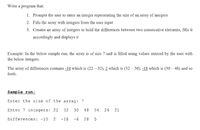
Database System Concepts
7th Edition
ISBN: 9780078022159
Author: Abraham Silberschatz Professor, Henry F. Korth, S. Sudarshan
Publisher: McGraw-Hill Education
expand_more
expand_more
format_list_bulleted
Concept explainers
Question
write the java

Transcribed Image Text:**Program Explanation for Finding Differences Between Consecutive Elements in an Array**
In this educational module, we will guide you through creating a program that performs the following tasks:
1. **Prompts the user to enter an integer representing the size of an array of integers.**
2. **Fills the array with integers from the user input.**
3. **Creates an array of integers to hold the differences between two consecutive elements and displays it accordingly.**
### Example:
For illustration, consider an example where the array is of size 7 filled using values entered by the user.
The array of differences contains:
- `-10` which is `(22 - 32)`,
- `2` which is `(32 - 30)`,
- `-18` which is `(30 - 48)`,
- and so forth.
Here is a sample run of the program for clarity:
**Sample run:**
- **Enter the size of the array:** `7`
- **Enter 7 integers:** `22 32 30 48 54 26 21`
- **Differences:** `-10 2 -18 6 28 -5`
The program takes the user input as follows:
1. The size of the array (which is `7` in this example).
2. Then, it takes `7` integer values input by the user to fill the array: `22, 32, 30, 48, 54, 26, 21`.
3. Finally, it computes the differences between each pair of consecutive elements and displays an array of these differences.
### Explanation of Differences:
- The difference between the 1st and 2nd elements: `22 - 32 = -10`.
- The difference between the 2nd and 3rd elements: `32 - 30 = 2`.
- The difference between the 3rd and 4th elements: `30 - 48 = -18`.
- The difference between the 4th and 5th elements: `48 - 54 = -6`.
- The difference between the 5th and 6th elements: `54 - 26 = 28`.
- The difference between the 6th and 7th elements: `26 - 21 = 5`.
By following these steps, you can create a program that efficiently calculates and displays the differences between consecutive elements in an array.
Expert Solution
This question has been solved!
Explore an expertly crafted, step-by-step solution for a thorough understanding of key concepts.
Step by stepSolved in 2 steps

Knowledge Booster
Learn more about
Need a deep-dive on the concept behind this application? Look no further. Learn more about this topic, computer-science and related others by exploring similar questions and additional content below.Similar questions
Recommended textbooks for you
 Database System ConceptsComputer ScienceISBN:9780078022159Author:Abraham Silberschatz Professor, Henry F. Korth, S. SudarshanPublisher:McGraw-Hill Education
Database System ConceptsComputer ScienceISBN:9780078022159Author:Abraham Silberschatz Professor, Henry F. Korth, S. SudarshanPublisher:McGraw-Hill Education Starting Out with Python (4th Edition)Computer ScienceISBN:9780134444321Author:Tony GaddisPublisher:PEARSON
Starting Out with Python (4th Edition)Computer ScienceISBN:9780134444321Author:Tony GaddisPublisher:PEARSON Digital Fundamentals (11th Edition)Computer ScienceISBN:9780132737968Author:Thomas L. FloydPublisher:PEARSON
Digital Fundamentals (11th Edition)Computer ScienceISBN:9780132737968Author:Thomas L. FloydPublisher:PEARSON C How to Program (8th Edition)Computer ScienceISBN:9780133976892Author:Paul J. Deitel, Harvey DeitelPublisher:PEARSON
C How to Program (8th Edition)Computer ScienceISBN:9780133976892Author:Paul J. Deitel, Harvey DeitelPublisher:PEARSON Database Systems: Design, Implementation, & Manag...Computer ScienceISBN:9781337627900Author:Carlos Coronel, Steven MorrisPublisher:Cengage Learning
Database Systems: Design, Implementation, & Manag...Computer ScienceISBN:9781337627900Author:Carlos Coronel, Steven MorrisPublisher:Cengage Learning Programmable Logic ControllersComputer ScienceISBN:9780073373843Author:Frank D. PetruzellaPublisher:McGraw-Hill Education
Programmable Logic ControllersComputer ScienceISBN:9780073373843Author:Frank D. PetruzellaPublisher:McGraw-Hill Education

Database System Concepts
Computer Science
ISBN:9780078022159
Author:Abraham Silberschatz Professor, Henry F. Korth, S. Sudarshan
Publisher:McGraw-Hill Education

Starting Out with Python (4th Edition)
Computer Science
ISBN:9780134444321
Author:Tony Gaddis
Publisher:PEARSON

Digital Fundamentals (11th Edition)
Computer Science
ISBN:9780132737968
Author:Thomas L. Floyd
Publisher:PEARSON

C How to Program (8th Edition)
Computer Science
ISBN:9780133976892
Author:Paul J. Deitel, Harvey Deitel
Publisher:PEARSON

Database Systems: Design, Implementation, & Manag...
Computer Science
ISBN:9781337627900
Author:Carlos Coronel, Steven Morris
Publisher:Cengage Learning

Programmable Logic Controllers
Computer Science
ISBN:9780073373843
Author:Frank D. Petruzella
Publisher:McGraw-Hill Education